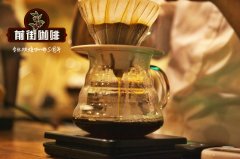The Origin of Intelligentsia Coffee Coffee for American intellectuals

Professional coffee knowledge exchange More coffee bean information Please pay attention to coffee workshop (Weixin Official Accounts cafe_style)
In 1850, coffee first appeared in the United States in powder form, so that coffee is no longer just a bourgeois luxury, ordinary families also have the opportunity to enjoy the delicious coffee. After entering the 20th century, with the end of the two world wars, instant coffee became an opportunity for coffee to enter the mass market, and coffee officially became a part of popular culture. In this way, coffee has entered people's daily life for more than 100 years, and coffee has undergone three major changes in this century.
The third wave of coffee revolution
The first wave of the coffee revolution was instant coffee for home use, followed in the 1960s by Alfred Peets, who used espresso as a base to create a variety of coffee flavors that were immediately popular when they first appeared in his coffee shop Peets 'Coffee. His decisive initiative improved the quality of coffee for business, and Starbucks was born five years later, catching up with Peez Coffee step by step and leaping onto the world stage to become the most famous coffee shop chain in the world. In order to maintain the consistency of coffee quality, Starbucks adopts the method of dark roasting to provide a large number of coffee produced without losing the level of performance. Coffee shops are no longer just places to drink coffee, but spaces for people to share life and culture. Commercial production gives coffee shops a new definition.
Today, coffee culture has ushered in a new era-the "Third Wave of Coffee Revolution". The third coffee revolution belongs to the world of fine coffee, which is no longer a pursuit of mass production, but a pursuit of the highest quality in all processes from planting to processing to brewing. At the center of this ripple are the "three great American roasters," including Stumptown Coffee Roasters, Counter Culture Coffee, and Intelligentsia Coffee, who led the revolution that began in the United States and spread to coffee markets around the world.
Among the three companies, Intellectual Coffee has only about 10 branches, but its influence is beyond imagination. When intellectual coffee first began trading directly with coffee producers, it had fewer branches, and it was hard not to wonder about a company so small that it had become a representative of the industrial revolution.
Start direct trade in raw beans
Intellectual coffee has a unique way of buying green beans. A few years ago, it would have been almost impossible for an independent coffee shop to buy green beans directly from where they were grown. Limited by time and money, the only way is to purchase through agents. However, this method has many disadvantages for producers and buyers because of the structural problems of the industry. Generally speaking, farmers and producers have no choice but to rely on middlemen. Middlemen have been making huge profits by exploiting the information gap between the two for many years. Farmers can only continuously reduce their prices to maintain the market competitiveness of raw beans, while buyers often buy raw beans that fail to pass inspection at a high price.
This defect made Doug determined to break with tradition and purchase raw beans in person. When Doug started the direct trade of raw beans, the establishment of Intellectual Coffee was not long ago, but Doug did not give up. After several years of hard work, Doug finally signed the first paper direct trade contract in early 2003. In 2008, he began to introduce a large number of raw beans directly. Now, more than 20 coffee estates maintain a stable and close direct relationship with them, several of which are exclusive transactions.
Direct trade secures farmers 'income and allows them to focus more easily on improving the quality of their crops and no longer suffer from lack of livelihood. Doug is happy to be able to maintain quality crop yields and help struggling coffee plantations as the company continues to grow, and hopes that more and more people will appreciate fine coffee in the future.
One-to-one order service
In addition to coffee, intellectual coffee is also served in a different way than ordinary coffee shops. In Venice, for example, each side of the coffee bar has a work space for two or three baristas working at the same time. Customers check out at the checkout counter and wait until their turn to order from the barista at the coffee bar, similar to the way we usually wait for our number to be called when we go to the bank. Here, waiting for the queue outside the door is a common thing, if the rush hour, you have to wait for more than 30 minutes of psychological preparation. The Venice branch has nine baristas and four barista assistants, as well as three cleaning staff.
Venice branch space design choice to barista as the center, although for some guests may be a little uncomfortable, but if the barista operation convenience as a priority, naturally can buy to provide customers with the most perfect coffee, on the other hand, perhaps this is the intellectual coffee attention to customers intimate performance bar.
This article is from La Vie's book "Fine Coffee Entrepreneurship"
Important Notice :
前街咖啡 FrontStreet Coffee has moved to new addredd:
FrontStreet Coffee Address: 315,Donghua East Road,GuangZhou
Tel:020 38364473
- Prev

The coffee is hot, but the coffee shop is getting cold. how to run the coffee shop?
Professional coffee knowledge exchange more coffee bean information please follow the coffee workshop (Wechat official account cafe_style) on May 8, Luckin Coffee, who strongly occupies advertising space in moments and elevators, held a brand conference to announce the official opening of the business. In this 4-month trial operation, it is needless to say that Luckin Coffee is hot. The data released by Lucky show that
- Next

How does American intellectual coffee sell coffee? The intellectual coffee icon has a story.
Professional coffee knowledge exchange more coffee bean information Please follow the coffee workshop (Wechat official account cafe_style) I like to drink coffee, at least one cup a day, sometimes two cups, but no more, my heart can't stand it. I started drinking at Starbucks when I was a student, and then the Seesaw in Shanghai opened to drink there, and then small cafes sprang up everywhere, and I noticed that on the menu
Related
- What documents do you need to go through to open a coffee shop? coffee shop coffee shop certificate processing process
- How to purchase Coffee beans in small Cafe how to choose a suitable supplier for domestic Coffee supply Company
- How to drink Starbucks Fragrance White Coffee? how to make Australian White Coffee? what Italian coffee beans are recommended?
- The Story of Flora Coffee: the name of Flora Coffee Bean and the implication of the Flowers on Florna Coffee
- How much does a cup of coffee cost? How much is the profit of a cup of coffee? What is the profit of the coffee shop in a year?
- Yunnan small Coffee, known as "fragrant Coffee", introduces the characteristics of Alpine Arabica Coffee producing areas in Yunnan, China
- 2023 latest Starbucks full menu price list how much is a cup of Starbucks coffee what is better to drink the most popular hot and cold drinks recommended
- Starbucks different kinds of Coffee Price list Starbucks menu 2023 Top Ten Best drinks in Starbucks
- Starbucks Spring praise Comprehensive matching Coffee Bean theme Story Packaging implication and taste description
- The cost of a cup of coffee latte American coffee cost price and selling price

